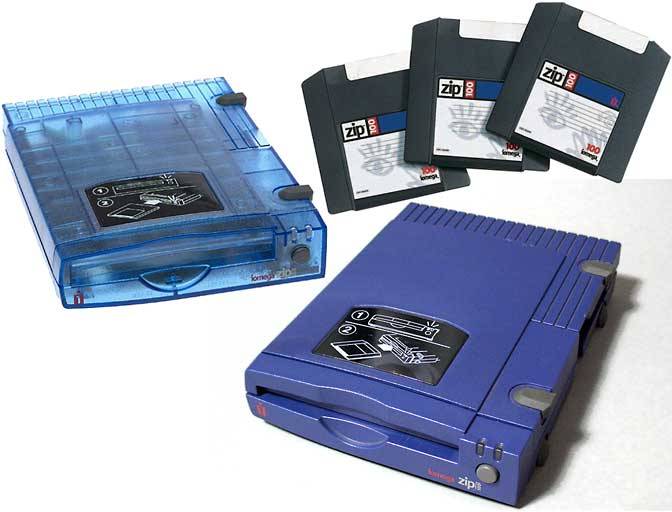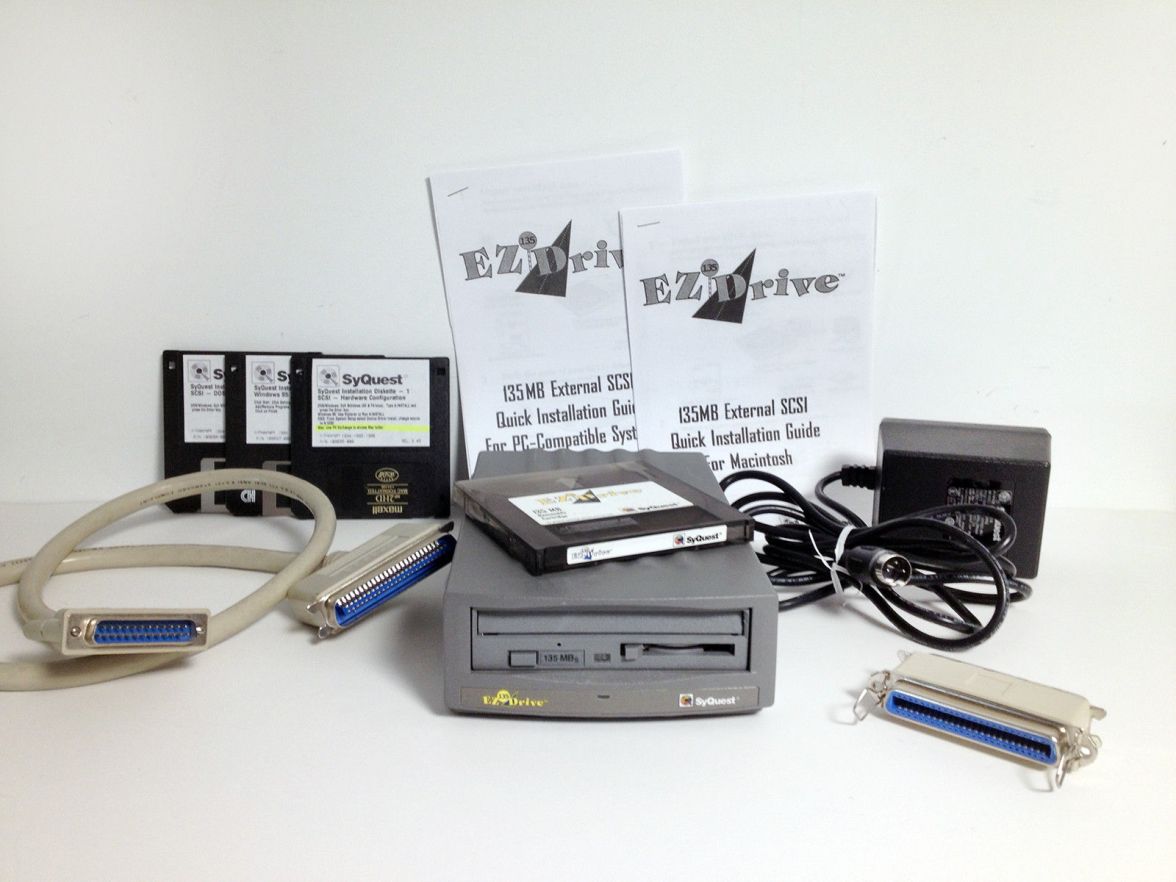Browsing eBay one day I was surprised to happen upon a listing for a SyQuest EZ-135 drive/catridge system, featuring removable 135 MB disks and a rather chunky looking SCSI-interfaced external drive. At first blush, this seemed remarkably like the Zip-100/250 drive/catridge systems that I am so familiar with, and yet completely new – I had never heard of an EZ-135 before! Intrigued, I dug into this unfamiliar “new” product further and uncovered not just a viable competitor to the Zip-100, but in fact a far superior product technically, albeit one that did not impact on the public consciousness to the extent that the Zip-100 did.
Cast your mind back to the early to mid-1990s. Hard drives were sold in capacities of 100’s of MB, and the then ubiquitous 3.5” floppy was the only game in town for backing up the precious contents of your hard drive (setting aside what I would consider to be the fragile and unreliable mechanism of tape backup). Backing up a few 100 MBs of hard drive onto 1.4 MB floppies required enormous discipline, patience and large numbers of the floppies. The backup programs of the day did their best to make this bearable, with as much compression as they could manage, floppy “sets” and so on, but it was still a chore. If you used Macs or PCs at the time, you will remember this not so fondly.

The stage was set for a better solution, a kind of “super floppy”, and in 1994, the Iomega Zip-100 burst upon the scene.

At 100 MB per cartridge, it took only a few Zip cartridges to back up your entire hard drive, and the write speed onto the Zip-100 cartridges was so much faster than the equivalent speed onto floppies that the time required to perform a backup was dramatically reduced. The Zip drive met a pressing market need and its fortunes blossomed.
In 1995, SyQuest entered the fray with its own super floppy, and the topic of this post, the EZ-135 drive/catridge system.

Like the Zip-100 it was competing with, it was SCSI-interfaced, featured large capacity removable cartridges and came in both external and internal formats. The Zip-100 had about a six month market lead on the EZ-135, but (as we shall see) the EZ-135 was a higher capacity, faster and better product. What happened? Well, not what you might expect. Have YOU ever heard of the EZ-135? I hadn’t! I bet you haven’t either, but I bet that you know all about the Zip-100!
Let’s have a look at these two competitors.
Iomega Zip-100
Introduced in late 1994.
Key specs:
- Capacity: 100 MB
- Average Seek Time: 30ms
- Sustained Transfer Rate: up to 1.4 MB/s
- Reliability: problematic as the drives age
- Price: $200 with one disk included
These specs may not sound impressive to today’s eye, but compared to the then ubiquitous 3.5” floppy, they were stellar. The 3.5” floppy had a measly 1.4 MB capacity, a seek time of 200ms and an average transfer speed of 16 KB/s. The Zip drive looked like a real racehorse by comparison.
Zip-100 (and later Zip-250) drives were available in both internal and external formats. The internal format came in two flavors, IDE/ATAPI or SCSI. The external format was also offered in two different interfaces, Parallel or SCSI. A little known fact is that the parallel version was just the SCSI version with a Parallel-SCSI converter added internally! That Parallel interface really slowed the drive down however, reducing its transfer rate from 1.4 MB/s to 50 KB/s… still 3x better than a floppy however!
Operation was simplicity itself, and perfectly mimicked the floppy model. Under Mac OS, to mount a Zip-100 disk you simply popped it into the drive and it automatically spun up and mounted on the desktop. Dismounting was similarly straightforward and floppy-like: you simply dragged the desktop icon to the trash and it automatically dismounted the drive, spun it down and ejected it. Users familiar with keyboard shortcuts could accomplish the same dismount action by clicking on the desktop icon and selecting Apple-Y (the “put away” command).
Under DOS/Windows, operation was predictably more cumbersome, but under Windows 9.x, the paradigm was quite simple to navigate.
The software that was included with the drive was quite good. Iomega drivers and utility programs were nicely designed and solid, and the Guest application was very versatile when needed. Support was available from Mac System 6 onward, and for the Wintel camp was available from DOS right through Windows 9x. I *believe* that it carried forward into the Windows XP and later era, but have not confirmed this.
As evidenced by this post, Zip drives remain popular amongst retro computing enthusiasts. The reason for this is slightly different than the reason for their original popularity however. Now it is all about getting files ONTO the computers, not copying the files OFF of the computers (i.e. backup)! Bulk loading of software and files onto older vintage computers has become the main use case for the Zip-100 class of drives, and has in fact featured in at least two recent posts in this blog!
SyQuest EZ-135
Announced in 1995.
The EZ-135 was the “Six Million Dollar Man” to the Zip-100’s “human”: it was “better… stronger… faster” than its competitor, as clearly reflected in the key specs below.
Key specs:
- Capacity: 135 MB
- Average Seek Time: 13.5ms
- Sustained Transfer Rate: up to 2.4 MB/s (burst transfer up to 4 MB/s)
- Reliability: Mechanism rated for 200,000 hours
- Price: $220 with one disk included
Like the Zip-100, the EZ-135 was available in both internal and external formats. Internal was IDE/ATAPI or SCSI. External was parallel or SCSI. Also like the Zip-100, a higher capacity version debuted in 1996: the EZFlyer, which had 230 MB disks.
Operation of the drive could apparently be more complex than operation of the Zip-100, but full details on that will come in my next post. I have acquired a set of EZ-135 drives on eBay, and will report on my experience of installing and using them as part of this series of EZ-135 posts. In the meantime, a review written at the time, and accessed today via the wonderful WayBackMachine, mentioned the need to manually mount, dismount, spin up, spin down and eject the disk. While this sounds like a few more steps than is needed in the floppy paradigm, as long as each step is reliable and simple, the net effort is not that much of a detriment.
The software that came with the EZ-135 was, like the software that came with the Zip-100, very good. Each EZ-135 came with a copy of LaCie Silver Lining Lite, a very nice disk utility/maintenance package and a SCSI probe utility that could recommend the SCSI ID to set on the drive. Support was provided from System 6.0.5 right through Mac OS 9.x.
So What Happened?
As a class, super floppies faded from view in the early 2000’s as hard drives burgeoned into the GB range, USB flash drives became commonplace and a 100’ish MB backup drive no longer solved the backup need. During their heyday however, super floppies solved a very real and very pressing problem and were a valuable part of the arsenal of any computer user who was concerned about their data security/longevity. I was one of those, and I remember being able to backup all of my files onto just five Zip-100 cartridges, and loving it.
As for the EZ-135, despite being a technically superior product, it failed to dominate. Most people (myself included) don’t even remember it from “back then”. The ZIP drive zoomed in popularity and the EZ-135 slowly faded away. Perhaps it was the bulky size of the EZ-135 drive, or maybe the slightly higher price point per disk (each disk was about $5 more than its Iomega counterpart) or even perhaps the cool blue design language that characterized the Zip-100 product, vs. the dull gray and garish yellow that SyQuest used for the EZ-135 family… it is hard to say. In the end, better technology doesn’t always win, and this was the case with the EZ-135.
Coming Up Next Time
As I mentioned above, I have acquired a pair of EZ-135s on eBay, and some cartridges to go with them, and will be installing and testing them next. I will report back my experiences in upcoming posts, as the results dictate. Stay tuned!
Sources:
- Wikipedia
- Florin Neumann, florin@quartz.geology.utoronto.ca, article “Comparison of Zip and EZ-135 drives” published on the web Mar 11, 2007 and accessed via WayBackMachine

Hi, is it possible to post the EZ135 SCSI manual?